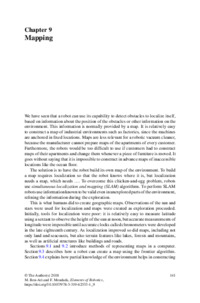Mapping |
 |
 Diese Seite wurde seit 7 Jahren inhaltlich nicht mehr aktualisiert.
Unter Umständen ist sie nicht mehr aktuell.
Diese Seite wurde seit 7 Jahren inhaltlich nicht mehr aktualisiert.
Unter Umständen ist sie nicht mehr aktuell.
 Zusammenfassungen
Zusammenfassungen
 A robot uses a map to localize its position. Maps can be loaded into the robot, but often the robot must create a map by itself. Maps are represented using either a grid showing which cells are occupied and which are free or a continuous map containing the coordinates of the obstacles. For a grid map the frontier algorithm enables the robot to explore its environment in order to determine the probability that each cell is occupied or free. A robot can use knowledge of its environment, for example, that it is in a building with rectangular rooms, to facilitate building a map. Algorithms for simultaneous localization and mapping enable a robot to perform these two tasks together, using data from localization and its sensor to extend the map and data from the map to achieve accurate localization.
A robot uses a map to localize its position. Maps can be loaded into the robot, but often the robot must create a map by itself. Maps are represented using either a grid showing which cells are occupied and which are free or a continuous map containing the coordinates of the obstacles. For a grid map the frontier algorithm enables the robot to explore its environment in order to determine the probability that each cell is occupied or free. A robot can use knowledge of its environment, for example, that it is in a building with rectangular rooms, to facilitate building a map. Algorithms for simultaneous localization and mapping enable a robot to perform these two tasks together, using data from localization and its sensor to extend the map and data from the map to achieve accurate localization. Dieses Kapitel erwähnt ...
Dieses Kapitel erwähnt ...
 Anderswo finden
Anderswo finden
 Volltext dieses Dokuments
Volltext dieses Dokuments
 |  Mapping: Artikel als Volltext bei Springerlink ( Mapping: Artikel als Volltext bei Springerlink ( : :  , 1015 kByte; , 1015 kByte;  : :  ) ) |
 Anderswo suchen
Anderswo suchen 
 Beat und dieses Kapitel
Beat und dieses Kapitel
Beat hat Dieses Kapitel während seiner Zeit am Institut für Medien und Schule (IMS) ins Biblionetz aufgenommen. Er hat Dieses Kapitel einmalig erfasst und bisher nicht mehr bearbeitet. Beat besitzt kein physisches, aber ein digitales Exemplar. Eine digitale Version ist auf dem Internet verfügbar (s.o.). Aufgrund der wenigen Einträge im Biblionetz scheint er es nicht wirklich gelesen zu haben. Es gibt bisher auch nur wenige Objekte im Biblionetz, die dieses Werk zitieren.










 Algorithmus
Algorithmus Roboter
Roboter
 Biblionetz-History
Biblionetz-History